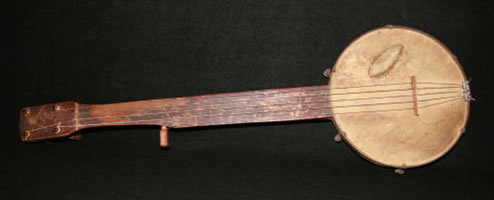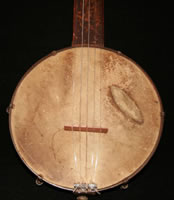Instruments:
Banjo
Perhaps no other instrument has been more deeply associated with the mountains of the southeast than the banjo. Through Hollywood portrayals, media stereotyping, and the recent rise in popularity of Bluegrass music, the banjo has become became inextricably linked to the people of the southern Appalachians.
First introduced to the United States by African Americans in southern slave communities, the early banjo was construed with a gourd head and four gut or vine strings. Early, relatively primitive designs of the instrument are African in origin and modern (designs) vaguely resemble these early versions. The banjo was introduced to Anglo-American culture in the early nineteenth century. It quickly underwent important changes in structure and construction. The gourd head used in the African and early forms of the instrument was replaced by a wooden rim design. By 1850, some forty years after the date believed to signify the initial crossover into Anglo-American culture, the gourd sound chamber design had almost entirely disappeared. 1 In the mid-nineteenth century, the addition of a fifth “drone” string proved to be the most significant adaptation. It is nto clear whether this development occurred in Arican American or Anglo-American playing circles. Regardless of who made this modification, the impact on the playing style of the instrument cannot be understated. The fifth string fundamentally altered the way the banjo was played and the sound that it produced. It was this alteration that brought the banjo from an African instrument to what John and Alan Lomax described as “America’s only original folk instrument.” 2
In the first decades of the twentieth century, radio popularized “hillbilly” music and manufacture of the instrument increased rapidly. 3 Catalogs like Sears and Roebuck distributed manufactured instruments across the nation. No doubt many of these banjos were purchased in the highlands of the South, but there remained a significant output in this region of instruments made by hand. Despite the rise of factory-produced instruments, local artisans continued to produce banjos for their community, often using factory-made versions as a model for design. 4
As with many other handcrafted products, the end result varied from maker to maker. More primitive designs were made entirely of wood, utilized tin cans for rim construction, and occasionally adapted parts from other instruments. 5 More complex, higher quality instruments were designed with a keener sense of how materials and designed affected performance. Hardwoods like hickory, walnut, maple, and poplar were favored for the construction of the head as their greater density tended to reflect the sound more, making it slightly louder. 6 Pine was also used but less frequently. Craft Revival era instrument maker Homer Ledford of Lexington, Kentucky used “curly maple in the fancy models,” and all walnut in the fretless mountain types. 7
After the wood was cured, the instrument’s parts were fashioned using rasps, pocketknives, and handsaws. The wood for the rim or hoop was boiled or steamed and bent into shape. Then a skin of some sort, often groundhog and catskin the most common, was stretched across and tacked down to form the head of the instrument. 8 Handmade versions often had a smaller diameter head than manufactured models. After visiting western North Carolina, folklorist and writer Louise Rand Bascom noted in a 1909 article for the Journal of American Folklore that “the banjo is home-made, and very cleverly fashioned, too, with its drum head of cat’s hide, its wooden parts of hickory.” 9
The carved neck would next be attached and strings added to complete the work. While factory-produced examples often had frets along the neck to mark finger positions, handmade banjos usually did not. This allowed for the sliding of notes, a preferred method in the old-timey string band style. 10
Born in 1910, Leonard “Lucky” Glenn began making banjos as a boy in the Laurel Creek community of Watauga County, North Carolina. Awarded with the North Carolina Folk Heritage Award in 1992, his instruments were a favorite among traditional style banjo players. 11 Rejecting the metallic sounding manufactured banjos, Mr. Glenn and other makers of hand-made versions produced an instrument with a softer tone that much better suited the singing and playing styles of many mountain communities. His longevity as a maker, and accolades as a craftsman, is a testament to the continued demand for the unique sound produced by the “mountain” banjo. 11
- Patrick Velde
See More: Banjos
1. Cecilia Conway, African Banjo Echoes in Appalachia: A Study of Folk Traditions (Knoxville, TN: University of Tennessee Press, 1995), 164, 173.
2. John and Alan Lomax as quoted in Conway, 160.
3. Karen Linn, That Half-Barbaric Twang (Chicago: University of Illinois Press, 1991), 82.
4. Vaughn Webb, “Instrument Making,” in Encyclopedia of Appalachia (Knoxville, TN: University of Tennessee Press 2006), 1175.
5. John Rice Irwin, Musical Instruments of the Southern Appalachian Mountains (Exton, PA: Schiffer Publishing, 1983), 61.
6. Eliot Wigginton (Ed.) Foxfire 3 (New York: Anchor Books, 1975), 138.
7. Edward Dupuy, Artisans of the Appalachians (Asheville, NC: Miller Printing, 1967), 75.
8. Irwin, 31.
9. Louise Rand Bascom, “Ballads and Songs of Western North Carolina,” Journal of American Folklore v. 22, n. 34 (April-June 1909): 238.
10. Henry Glassie as qouted in Conway, 179.
11. “Leonard Glenn: Banjo and Dulcimer Maker,” North Carolina Folklore Journal/44, nos. 1-2 (1997): 62-63, and Thomas McGowan, “Leonard Glenn, 1910-1997,” North Carolina Folklore Journal/45, no. 2 (1998): 93-94





